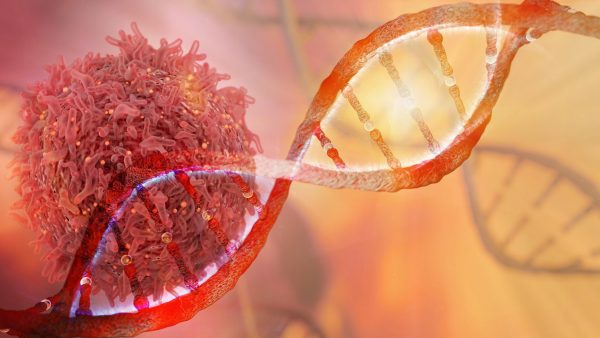The American College of Medical Genetics and Genomics (ACMG) has released an important new clinical practice resource from a global team of specialists in cancer genetics that will help inform the clinical management of patients who are at increased risk of breast cancer, pancreatic cancer and likely ovarian cancer.
PALB2 (Partner and Localizer of BRCA2) germline pathogenic variants are associated with substantially increased breast cancer risk and smaller increased risk for pancreatic and ovarian cancer. Germline pathogenic/likely pathogenic (P/LP) variants in PALB2 were first associated with increased cancer risk in 2007, for which Dr. Marc Tischkowitz, an Assistant Professor in the Department of Human Genetics at McGill at the time, was also first author, and clinical testing has been available since then. It has come to be considered as the third most important breast cancer gene after BRCA1 and BRCA2. Despite the emerging importance of this gene, there has been a dearth of resources to guide clinical management of women and men with PALB2 germline P/LP variants.
“PALB2 is sometimes referred to as ‘BRCA3,’ given its importance in risk of breast cancer. People who harbor a germline pathogenic or likely pathogenic variant in PALB2 face challenging questions, especially about their personal risk to develop cancers of the breast, ovaries and pancreas, and how to manage that risk. In developing this clinical practice resource, we sought to help guide patients and their treating providers to make the best possible decisions based on current high-quality peer-reviewed evidence and a worldwide network of practicing physicians with expertise in cancer genetics,” said Dr. Douglas R. Stewart, co-author and past chair of the ACMG Professional Practice and Guidelines Committee.
Key recommendations include the following:
- Personalized risk estimates (e.g., CanRisk) should be used in guiding clinical management.
- PALB2 VUS (variants of uncertain significance) should not be used to guide clinical management.
- Prospective collection of clinical data from PALB2 patients should be used to establish clear metrics on treatment outcome and survival.
- PALB2 patients should be offered similar surveillance to BRCA1/2, modified according to individual risk
- Risk reducing mastectomy can be considered as an option, guided by personalized risk assessments.
- Pancreatic cancer surveillance may be considered in the context of family history, ideally as part of a clinical trial.
- Ovarian cancer surveillance should not be offered; risk reducing salpingo-oophorectomy (surgery to remove the ovaries and fallopian tubes) should include shared decision making and should rarely be considered before the age of 50.
- Given the mechanistic similarities, PALB2 patients may be considered for therapeutic regimens and trials as those for BRCA1/2.
- ACMG does not recommend testing partners of PALB2 patients in the reproductive setting unless it can be justified by the partner’s family history of cancer.
This Clinical Practice Resource concludes that this guidance is similar to those for patients with BRCA1/2. While the range of the cancer risk estimates overlap with BRCA1/2, it is lower in PALB2, so individualized estimates are important for management decisions. Systematic prospective data collection is needed to determine, as yet, unanswered questions, such as the risk of contralateral breast cancer and survival after cancer diagnosis.
“In 2007, we and two other groups identified PALB2 as a breast cancer susceptibility gene,” said Dr. William Foulkes, Professor in the Departments of Medicine, Oncology and Human Genetics at McGill University and a member of the international team. “In 2014, and more recently in 2020, the breast cancer risk associated with alterations in this gene were accurately determined. This led an international group to produce these clinical guidelines that will have wide applicability. I am very happy to see that this work, starting in Montreal from two families we met in medical genetics clinics at the Jewish General Hospital and McGill University Health Centre, has led to this important new publication.”
“This new document is landmark for the ACMG in a couple of ways,” said Dr. Marc S. Williams, president of the American College of Medical Genetics and Genomics. “First, it reflects a commitment of the ACMG to develop guidance for use of germline genetic information for the treatment of patients with cancer. Second, this represents the first of what we hope will be many guidance documents that reflect a diverse, global perspective. The working group included experts on PALB2 from around the world so that the guidance will have relevance for patients from diverse backgrounds receiving care in a variety of settings,” he said.
The global team of authors for this new Clinical Practice Resource includes Marc Tischkowitz, MD, PhD, Judith Balmana, MD, PhD, William D. Foulkes, MB BS PhD, Paul James, MD, PhD, Joanne Ngeow, MBBS, MPH, Rita Schmutzler, MD, Nicoleta Voian, MD, MPH, Myra J. Wick, MD, PhD, Douglas R. Stewart, MD and Tuya Pal, MD and the ACMG Professional Practice and Guidelines Committee. They are experts in clinical cancer genetics, breast and gynecologic surgery and medical oncology and practice in Australia, Asia, the United States, Canada, the United Kingdom and Europe.

